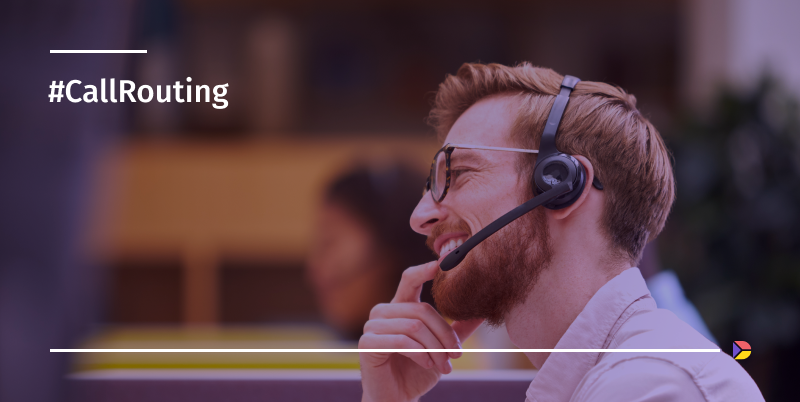Ready to improve your marketing ROI?
Fast registration. User-friendly interface. Robust integrations.
Disclaimer: By automating phone transfers, call routing may dramatically boost any company's performance.
In an ideal world, a client calls a company, immediately connects to a competent agent, receives help, and hangs up filled with happiness and satisfaction. An agent answering the phone is focused but calm, as the next call appears only in 10 minutes. Unfortunately, such a situation is not feasible for any business. The painful reality is often like that: customers prefer calling all at the same time, known as peak hours; they all have different requests; agents are stressed because of the workload; callers are stressed because of the long pauses. There is no data regarding the number of missed calls, as well as no information about the sources that made the customers dial a number. As a result, nobody is happy, and there are no ideas on how to handle everything.
To reduce the chances of the worst-case scenario happening to your business, it is useful to implement a call routing solution. You will avoid hectic workdays and it will allow you to improve both customer satisfaction and working efficiency. In this article, we will focus on the principles, benefits, and types of call routing in more detail.
First, let’s make the terminology clear.
Agent - is a person answering inbound calls.
Destination - is an agent that handles inbound calls. If an advertising campaign has several destinations, i.e., several agents are ready to talk to calling customers. Destinations are usually set in the parameters of an advertising campaign when you are dealing with call-tracking software.
How does call routing work?
Call routing is the setting up of several destinations for inbound calls. If the first agent is busy, the second one picks up the phone. Another condition may be the limit on the number of calls that each agent can handle or restrictions on the allocated budget for the call minutes. Therefore, the system uses the schedules and restrictions as an algorithm to direct inbound calls to an available agent.

Depending on the provider you choose, the functionality may vary. Companies dealing only with call routing solutions provide users with a wider choice of call routing types. For instance, it is possible to divide calls between agents according to the time they are on hold (uniform call routing), or allow agents to demonstrate the speed of reaction (simultaneous call routing), etc.
Sometimes users are looking for a universal solution capable of dealing with several related tasks. It may be an option in terms of saving money or limited resources, as with a universal solution you spend less time on the learning curve and do not dive deep into details. Call routing may appear as a complementary feature of the call tracking solution functionality, for instance.
Methods of setting up call routing
Priority and weight parameters
When setting up destinations for inbound calls, those destinations are given a certain priority and weight. A priority figure indicates which of the destinations will handle a call first-hand. An agent with the second priority will talk to a caller only if the first one is unavailable.
Weight is considered among destinations with equal priority. It is usually specified in percentage rates and indicates the allocation of calls among the agents. Agents take an equal number of calls if the weight is 100% for all of them. If one agent has a weight of 70% and the other 30%, i.e., the second agent will answer half as many calls as the first one. This feature is helpful while training new staff and limiting the number of inbound calls for them or if one of the agents works part time.
Round-robin type
With this type of call routing, your team will receive an equal number of calls to process. When the priority is indicated as “1” for all destinations, each agent will receive the same number of interlocutors. This is called a round-robin type of call routing.
Interactive voice response (IVR)
IVR is another convenient way of assigning calls to experts. It is especially useful if you receive many calls and there are busy hours when it’s almost impossible to get through.
IVR is assigning an expert, department, or the most typical request a number. A caller listens to available options and makes a choice. As a result, the process of reaching a required department takes a shorter time, which is especially important for huge corporations. A well-designed IVR menu also includes a call back request and an option to speak to a live agent if all other options are automated.

Benefits of call routing
- Shortened on-hold periods: Your customers will feel pleased without long waiting pauses. Call routing implies that an available agent takes a call if a colleague is busy. Therefore, there are fast call transfers and agents have an opportunity to relax between calls.
- Convenient working hours: Call routing operates according to the schedules set. Your company can hire several agents to work in shifts, providing customers with 24/7 support. Your agents will feel focused and be ready to work productively in such a situation. Such conditions are convenient for both callers and staff.
- Increased customer satisfaction: We feel it when we are treated right. Show your customers that you care with smooth call transfers, quick request solutions, clear instructions, and competent expert help. IVR and call routing are great tools to demonstrate your attitude to the target market.
- Lower costs: When you call a company and it turns out an agent on the line can’t help you, you are transferred to another agent or a different department. You feel more irritated with every transfer. You may even leave a negative review somewhere on a popular platform. For the company, this situation means higher call rates because all transfers take longer, and negative reviews harm their brand image. With call routing, your business avoids both unpleasant situations.
- Precise analytics: An option of a call back, added to the IVR menu, guarantees you will know the exact number of leads generated by your advertising campaigns. All the calls will be safely stored in the call log, letting you trace the effectiveness of the campaigns and assess the performance of your agents. This is very convenient for keeping the contact details of your customers and allows marketers to integrate this data into any existing CRM system.
- Error reduction: IVR routing is setting automated processes for inbound calls. Therefore, there is no risk of human factors. The system will connect callers to required destinations according to the settings, freeing the staff for more challenging tasks and saving the company’s budget on the salary of a receptionist.
- Brand image: A company with well-structured call routing features makes a positive impression on callers. It means your business is trusted and you have plenty of inbound calls that have to be handled.
What are the best practices for call routing?
Call routing is a useful tool capable of improving your business indicators. However, you should know how to customize the settings and get the most out of this solution. We have compiled a list of tips that must help in the way of adjusting call routing to your inner corporate processes.
Collect feedback
You can believe you require a call-routing service when in fact you don't. Do some research. Ask your callers if they enjoyed interacting with your business over the phone. They may mention the pauses when they were put on hold or the competence level of the agents. These revelations will show where the next actions should be taken. You may own a small business, and there is no pressing need for you to create an IVR menu; instead, you can invest your money in something more important.
Explore the calls
Careful analysis of the call recordings and other metrics can provide you with important ideas on how to improve the current performance. You may analyze the requests customers call you with.
- Can they be called typical?
- Can they be divided into thematic groups?
- Is it possible to automate part of them using a recorded voice of a virtual assistant?
- What is the percentage of unanswered calls? How can this indicator be changed?
- Will a solution to arrange your agents' working hours in shifts be productive?
Answers to the above-mentioned questions will lead you to conclusions regarding the necessity of designing an IVR menu and implementing a call routing.
Select the call routing type
The types vary depending on the availability of agents, the number of inbound calls, the allocation of calls in time, etc. As a result, a company should understand what it expects from a call routing solution and what issues it wishes to address. It is also crucial to choose a provider and study their functionality and pricing terms.
Create an IVR structure
The range of options that you will offer your clients depends on the careful research that has to be conducted. However, an IVR menu has some pitfalls that you should consider. To avoid customers’ frustration, limit the number of options. Options should be mentioned before actions to facilitate the process for the callers. If you run an international business, offer a multilingual menu and do not forget to include an option for a real agent to talk if most of the options are automated. There are always those who prefer to settle everything live. Test an IVR on a limited group of callers and collect the feedback.
Take the most out of your software
Call routing is a helpful feature. However, it functions best when used in conjunction with other call tracking options. For instance, call analytics may provide you information about the paths taken by your customers and assist with keyword research. You may save money by setting up pay per call campaigns and figuring out which traffic channel is the most effective. Your opportunities are further increased when a call routing system is integrated with CRM. Explore the solutions on the market to make a thoughtful decision.
Better call routing strategies improve the customer experience
The way you interact with your customers influences your brand image significantly. If you demonstrate competence and a positive attitude to all your clients, the question of customer retention will not exist for your business. People prefer to return if they feel they are treated well.
With call routing from Dialics, it becomes easier to show your caring attitude. You can set destinations and make the working process both effective and convenient for the staff. Call analytics show the areas where advertising campaigns can be improved. Dialics also offers international virtual phone numbers in case you decide to expand. The support team is available at any time and ready to assist at any time. Please contact us and we will be happy to help you grow your business.
FAQ
Is call routing legal?
What is the difference between call routing and call forwarding?
What is custom call routing?
What is a good conversion rate for PPC?
What is a good conversion rate on Amazon?
What is a good conversion rate for email marketing?
What is a good conversion rate for Facebook ads?
Ready to improve your marketing ROI?
Fast registration. User-friendly interface. Robust integrations.

